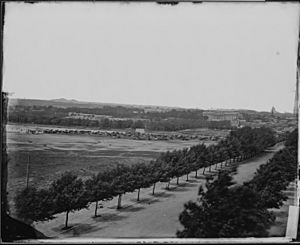Tiber Creek facts for kids
Quick facts for kids Tiber Creek |
|
|---|---|

National Archives at College Park
White Lot during the war, Washington D.C. Shows Tiber River, now "B" St., c. 1860–1865. |
|
| Other name(s) |
|
| Country | U.S. |
| District | District of Columbia |
| City | Washington, D.C. |
| Physical characteristics | |
| Main source | Shaw neighborhood 38°54′56″N 77°01′13″W / 38.9155556°N 77.0202778°W |
| River mouth | National Mall 38°53′26″N 77°02′21″W / 38.8906675°N 77.0391435°W |
| Basin features | |
| River system | Potomac River |
Tiber Creek, also known as Tyber Creek or originally Goose Creek, is a small stream in Washington, D.C.. It flows into the Potomac River. For many years, it was a natural creek. But in 1815, it was changed into a canal called the Washington City Canal. Today, Tiber Creek flows in tunnels hidden beneath the city, including under Constitution Avenue NW.
Contents
The Story of Tiber Creek
How Tiber Creek Got Its Name
This creek was first called Goose Creek. But in the late 1600s, a settler named Francis Pope bought land along the creek. He owned a large farm, about 400 acres. Pope decided to name his land "Rome" after the famous city in Italy. Because of this, he renamed the creek after Rome's own river, the Tiber.
From Creek to Canal
When Pierre Charles L'Enfant planned the city of Washington in 1791, he had a big idea for Tiber Creek. He wanted to make it wider and turn it into a canal. This canal would help boats move goods from the city to the Potomac River. By 1815, the western part of the creek became part of the Washington City Canal. This canal ran along where Constitution Avenue is now.
When the Canal Went Underground
By the 1840s, Washington D.C. didn't have a good system for storm drains or sewers. So, the Washington City Canal became a very smelly, open sewer. It was a big problem for the city.
In 1871, a group called the D.C. Board of Public Works started making big improvements. They fixed streets, planted trees, and built sewers. One of their main projects was to put Tiber Creek and the Washington City Canal underground. An engineer named Adolf Cluss helped build a large tunnel. This tunnel was big enough for a bus to drive through. It carried Tiber Creek underground from Capitol Hill to the Potomac River.
Buildings on Top of the Creek
Many buildings on the north side of Constitution Avenue are built right over where the creek used to be. For example, parts of the Internal Revenue Service Building sit on wooden poles sunk into the wet ground. In 2006, some buildings, including the National Archives Building and the IRS headquarters, had to close temporarily. This happened because the low ground and underground water caused flooding.
For a long time, land near 14th Street and Constitution Avenue was just a parking lot. It was too hard to build there because of the water underground. When the Ronald Reagan Building and International Trade Center was built (1990–1998), engineers had to move the water away. But this caused a new problem: the water level under the IRS building dropped. This made the wooden poles holding up the IRS building less stable, and part of the building's foundation started to sink.
Tiber Creek Today
Even though it's hidden, the stream flowing under the city is still often called Tiber Creek. Its history as a canal is an important part of Washington D.C.'s past.
Location and Path
Tiber Creek was once located southeast of Georgetown, Maryland. This area was chosen to become the new capital city of the United States, Washington. Today, this land is known as the National Mall.
Several small streams used to flow from the north and south. They met at the base of Capitol Hill. From there, they flowed west into the Potomac River near Jefferson Pier. When the Washington City Canal was built in 1815, it followed the same general path as the original creek.
Images for kids
-
Andrew Ellicott's revision of L'Enfant's Plan, showing Washington City Canal




